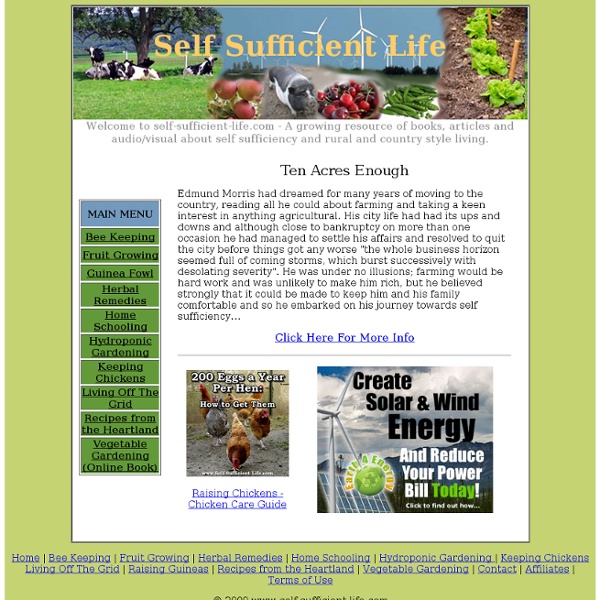



Living Primitively Practical self sufficiency through food skills. Homesteading | Country Living Orion Magazine - nature / culture / place Building Sustainable Farms, Ranches and Communities This guide is written for anyone seeking help from federal programs to foster innovative enterprises in agriculture and forestry in the United States. Specifically, the guide addresses program resources in community development; sustainable land management; and value-added and diversified agriculture and forestry. Thus, it can help farmers, entrepreneurs, community developers, conservationists, and many other individuals, as well as private and public organizations, both for-profit and not-for-profit. The guide can also help USDA and other agency employees become aware and take better advantage of the enormous array of federal programs and resources available to their clients in supporting agricultural and forestry innovations. Website design and maintenance as well as distribution of hard copies of this guide are conducted by the Appropriate Technology Transfer for Rural Areas (ATTRA) project of the National Center for Appropriate Technology
Emergency Food Preparedness Emergency food preparedness is something we all need to do, whether it's preparing for the loss of a job or a large-scale disaster. No matter where you're at in life, it's wise to start stocking up on emergency preparedness food now. But should you really go out and buy all those expensive, freeze-dried foods? The Beauty of Whole Grain Whole grains are an essential part of emergency food preparedness, but they're also a boon for saving money, improving your health and having some of the best tasting foods out there. Buy your grains in bulk, and invest in a grain mill. Make Your Own Pasta Emergency Food Preparedness And Wonderful Beans Buy plenty of beans in a wide variety and start cooking them every week. Also don't forget lentils, some of the easy legumes out there. Learn More About Being Prepared Learn More About Frugal Cooking Return from Emergency Food Preparedness to the Home Page
Institute How To Make Your Own Homemade Pain Relieving Cream Please Share This Page: Google + stumbleupon tumblr reddit If you are a first-time visitor, please be sure to like us on Facebook and receive our exciting and innovative tutorials on herbs and natural health topics! Image – OneGoodThingByJillee.com This is a great formula we just discovered for a homemade pain relieving cream. One tip we would definitely suggest is to read the comments on the original article. For those wanting to research this worthy subject in even greater depth – we have also created a couple of pages on the subject of natural pain relief that you might also be interested in, these contain many other suggestions: 10 Herbs For Pain Relief Top 20 Natural Painkillers In Your Kitchen Ok, here is the link to the full pain relieving cream tutorial:
penrhos home page permaculture design and sustainable developmen How to Make Magnesium Oil to Improve Sleep and Reduce Stress I’ve written before about how I use magnesium daily and why I feel it is such a vital part of overall wellness . Many people are deficient in this vital mineral that the body uses for hundreds of reactions. Every cell in the body needs magnesium in some way, and it is vital for bone, tooth, muscle and joint health as well as for optimal sleep and stress reduction. Deficiency of magnesium is widespread because many of us have lifestyle factors that actively deplete magnesium such as lack of sleep, excess stress, or alcohol/caffeine/sugar consumption. On top of that, many natural sources of magnesium are becoming depleted (such as the soil due to over-farming and high pesticide use) and water filtration systems remove much of the naturally occurring magnesium in water. I take magnesium internally and use it on my skin daily in the form of magnesium oil . What you need: What to do: Boil the distilled water. Stir well until completely dissolved. To Use: Spray on arms, legs and stomach daily.
Eco Truly Park -Volunteer Program 600 Reasons Turmeric May Be The World’s Most Important Herb Please Share This Page: Google + stumbleupon tumblr reddit If you are a first-time visitor, please be sure to like us on Facebook and receive our exciting and innovative tutorials on herbs and natural health topics! Image – Jag_cz – Fotolia.com We found a simply astonishing page all about Turmeric and had to share! There are several things that are amazing about the page we discovered. Then there is the fact that the mighty turmeric has been in use for over 6000 years, with an incredible safety record. Even more amazing is the way the article weaves a crystal-clear narrative that exposes the farce behind the fact that the modern medical world will perhaps never approve turmeric “officially” for medical use. But most amazing of all, to me, was the comment from the man who states calmly that he is one of the world’s longest survivors of the kidney transplant operation (34 years since the op, the world record is 40 years) and he takes capsules of turmeric (and other herbs) daily. Enjoy! ps.
Ice Energy